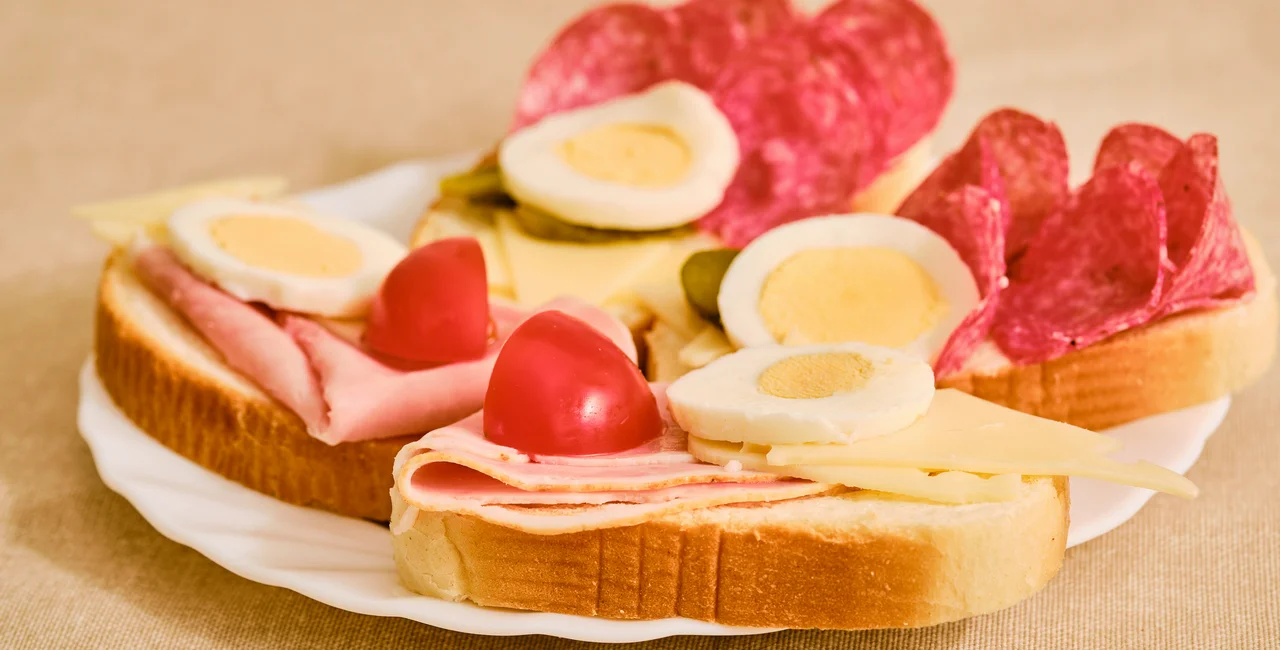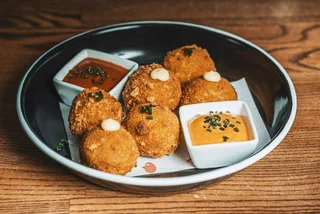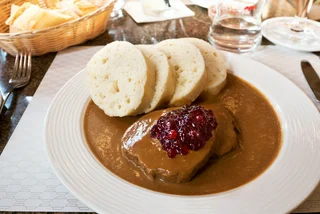This week marks the 130th anniversary of the chlebíček, the distinctive open-face sandwich found in cafés and delis across the Czech Republic and Slovakia.
Josef Lippert, a native of Žatec in North Bohemia, opened a specialty food shop on Prague’s trendy Na Příkopě Street on March 29, 1892. It offered unique delicacies such as pâté with real truffles or lobster chlebíček. The lahůdkářství was among the most famous of its kind in Czechoslovakia until World War II.
The full name of the dish is obložený chlebíček, but that is almost always shortened to just chlebíček, meaning “little bread.” The plural is chlebíčky, and it is common to have more than just one.
The versatile dish can be eaten for breakfast, lunch, or dinner. It is also a staple of buffets at all manner of formal and informal events. Each chlebíček is handmade, with toppings placed on a slice of veka, a type of bread similar to a French baguette.
The bread is sliced at an angle, to make a wide area to cover with toppings. The bread slice is then covered on top with butter or mayonnaise, and then toppings such as egg, pickles, salami, cheese, seafood salad, or vegetables are added. There are no fixed recipes. People can decorate the chlebíčky according to their own imagination.
Similar small bites preceded this most famed of Czech deli fare. Dark bread topped with herring was popular in Germany at the end of the 19th century. And small round canapés were also served at parties. The chlebíček was innovative because it was larger than a canapé, as the bread was cut at an angle. It could still be held in one hand and eaten in two or three bites while standing and socializing or enjoyed on a plate like a meal. The particular type of bread used was light in texture and went well with a wide range of toppings, so people could sample several varieties.
The chlebíček took a while to catch on, though. Jan Paukert, who opened his shop on Národní třída in 1916, is usually credited with bringing the sandwich to national prominence. The shop’s prime location near the National Theatre brought it an A-list clientele. The shop soon expanded, taking over adjacent spaces.
By the 1930s, Paukert counted many Czech celebrities among his customers: comedy team Jiří Voskovec and Jan Werich, and actors Hugo Haas, Lída Baarová, and Oldřich Nový, conductor Václav Talich, and opera singer Ema Destinnová, to name a few. Actor Vlasta Burian was such a fan of the sandwiches that he held parties at Paukert’s shop. The sandwiches were even delivered to First Republic President Tomáš Garrigue Masaryk.
The shop was nationalized in 1952, and Paukert died 20 years later in obscurity. An effort by his heirs to reopen the shop in the 2010s at its original location was not successful. A new bistro bearing the Jan Paukert name is in Prague’s Karlín district, and while it does serve chlebíčky, the focus is on fine dining.
But you can still get some authentic chlebíčky that have a significant provenance. Another shop in Prague called Lahůdky Zlatý kříž has been around for over a century, and now serves over 70 types of chlebíčky. It was founded in 1916 by Alois Zoufalý, and has changed hands several times. It also moved down the street a bit from its original location to Jungmannovo náměstí 34.
Ivana Klinderová, the current co-owner of Zlatý kříž, says that while some foods have garnered international appeal, the chlebíček has stayed a Czech secret. The most popular variety at Zlatý kříž has long been Russian egg (ruské vejce), recently renamed to golden egg, with a topping of egg, ham, pickle, red pepper, and parsley. Many of their other varieties have remained virtually unchanged through the decades.
“It’s a rarity because you can taste something that is exactly like it was back then when Mr. Zoufalý opened his delicatessen over a hundred years ago. It is unchanged,” Klinderová told us in 2016 when the shop had its centennial.
There is some skill to making the sandwiches.“We have to train people how to do it. Those salami roses aren’t easy; making chlebíčky is a real art form,” she added.
A tradition over the years has been to buy a small box of chlebíčky and eat them in the nearby Franciscan garden.
“If you haven’t had chlebicky this way you simply haven’t had Czech food,” she said.
Klinderová recently told the Czech News Agency (ČTK) that her shop isn’t only popular with Czechs, but also with tourists, especially from Japan. She also says that while she has added some vegetarian and fruit versions to the list of options, she prefers to stick to traditions rather than follow trends.












 Reading time: 4 minutes
Reading time: 4 minutes 




























